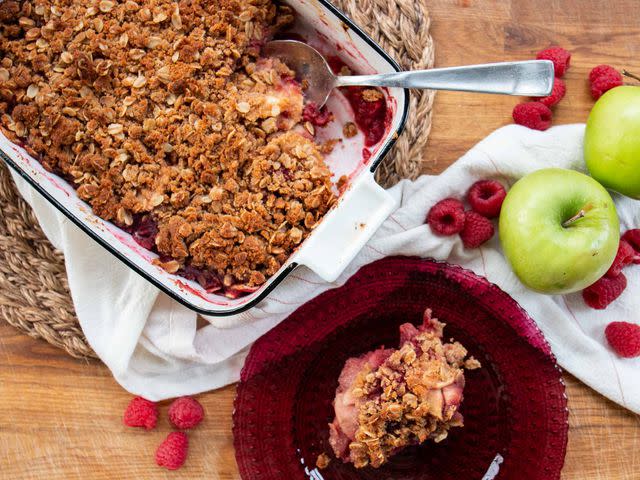How to Store Raspberries to Keep Them Fresh for Longer
Try these tips to maximize the storage life of delicate, often expensive raspberries.

Allrecipes/Getty Images
Fragrant, tart-sweet raspberries are one of nature’s most fragile fruits: It seems as if they could go from perfect to squashed and/or moldy with just a look. Their delicate nature is also what makes them pricy, as so much care goes into harvesting and packaging them. This makes handling and storage even more important at home, so you can enjoy the berries at their best (and not end up wasting money). Ahead, learn how to store and care for raspberries so they end up on your plate instead of in the trash.
How Long Do Raspberries Last?
The shelf life of fresh raspberries and other summer berries is generally very short—usually no more than a couple of days—so you’ll want to enjoy them sooner rather than later. Use fresh raspberries in a fresh sauce, classic British Eton Mess, or in a show-stopping White Chocolate Raspberry Cheesecake.

Dotdash Meredith Food Studios
How to Store Fresh Raspberries
Follow these step-by-step instructions to help keep your fresh raspberries at their best for as long as possible:
Place your raspberries in a single layer on paper towels, then let sit a few minutes to absorb any excess moisture. If any berries are squashed or moldy, go ahead and remove these now: Exposure to mold and moisture will spoil the rest of the raspberries faster.
Return the raspberries to their clamshell or perforated container. The airflow will help to keep the berries dry and free of mold. It isn’t a good idea to consolidate containers here, as the extra contact and pressure can damage the fruit.
Place the container of raspberries at the front of the shelf in your fridge, rather than at the back or in the crisper drawer (areas that can have a higher humidity). Storing them here is also a great visual reminder to enjoy them right away!
Gently wash raspberries right before serving. Pat dry with paper towels if adding to baked goods or whipped cream.

How to Freeze Raspberries
You can extend the life of your raspberries by several months by freezing them first. The trick is to clean first, then remove as much moisture as possible. The drier the berries when they’re frozen, the less ice crystals will form (what literally tears apart the fruit). Here’s how to do it:
Gently rinse in a colander and let drain for 10 minutes. Arrange in a single layer on paper towels and let sit until completely dry.
Place on a parchment-lined baking sheet, being sure the berries do not touch, and freeze until firm, 2 to 4 hours.
Transfer to an airtight resealable bag and freeze.

How to Thaw Frozen Raspberries
You can thaw frozen raspberries by refrigerating overnight or leaving on your counter until defrosted. Do not microwave them. Thawed frozen raspberries won’t have the same texture or flavor as fresh. Use them in smoothies, jams, and baked goods.
What are Freeze-Dried Raspberries?
Freeze dried raspberries are not fresh or frozen, but dried. You’ll often find them in the snack aisle of your grocery store. They are made by a commercial process that freezes them at sub zero temperatures, then vacuum dries them to remove all moisture. This gives the raspberries an airy, crispy texture and a nearly endless shelf life. Enjoy them as a snack or sprinkled over cereal or yogurt. You can also grind into a powder and fold into frosting or cream cheese.
Read the original article on All Recipes.


